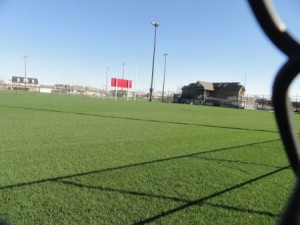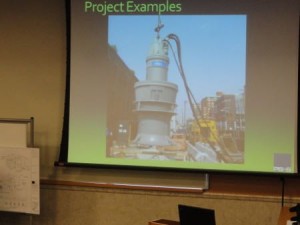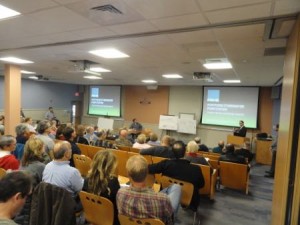The single outfall point for drainage from a 30-block area would be on the bay at the end of Sixth Street under a plan shared Saturday at a town hall meeting in Ocean City.
Ocean City residents heard an engineer on Saturday morning explain how a new hydraulic pump station will help drain water from a 30-square-block area in one of Ocean City's most flood-prone neighborhoods.

A pump station would be located underground at the soccer field at the corner of Sixth Street and Bay Avenue.
Likely starting sometime in early 2017, work will begin on an $8.7 million project to overhaul the drainage system between First Street and Seventh Street, Asbury Avenue and the bay.
Dave Applegate of of the engineering firm Paulus, Sokolowski and Sartor (PS&S) made a presentation on plans for the project during a town hall meeting Saturday (Nov. 14) at the Ocean City Free Public Library. More than 100 people attended the meeting.
Applegate shared plans to redirect stormwater from six or seven different outfall pipes leading to the bay to a single pump station on public property at the corner of Sixth Street and Bay Avenue. From there, six pumps would add muscle to the drainage flow of floodwaters from the streets. The pumps would then push water to a single point on the bay at Sixth Street at a rate as fast as 370 cubic feet per second, according to Applegate.
But with all drainage from the entire area directed to a single point, neighbors at Sixth and Bay had plenty of questions about the impact of the outfall — and many went unanswered.
THE PROJECT
Ocean City Finance Director Frank Donato said the project started with a grant application to the Federal Emergency Management Agency (FEMA) after the November 2009 nor'easter that caused flood levels Ocean City had not seen since 1992.

A slide shows the type of pump that would be installed (along with five others) on public property at Sixth Street and Bay Avenue.
Ocean City ultimately was awarded $4.984 million, the largest grant Ocean City has ever received. With the city contributing another $2.7 million in capital funding, the city set to work on the project. City Council approved a $118,400 contract with PS&S for design services.
Plans call for six pumps to be installed underground near a soccer field on the city-owned recreation property at the corner of Sixth Street and Bay Avenue. The machinery would be covered and the area resodded with only traditional manholes showing.
Electrical panels and backup generators would be stored in a new building constructed two feet higher than base flood elevation adjacent to an existing restroom facility.
Storm pipelines throughout the project area would be replaced and redirected to the pump station. Manufactured Treatment Devices (MTDs) would be installed at intervals to intercept solids and silts (with the intent of improving water quality). Applegate said the MTDs would have to be routinely cleaned in order to be effective, and he acknowledged that some silt and other material can travel through the MTDs.
The reconfiguration to eliminate outfall pipes would effectively end the possibility that tide water could travel backwards through the storm drain system to flood streets, as it often does. Three new adjacent outfalls at Sixth Street would be 54 inches in diameter. They would include new flap and flex valves to prevent back flow of water, according to Applegate. They would land in a "stilling basin" to mitigate the effects of a massive volume of water pouring into the bay at a high rate.
When tide levels are high enough to flow freely over bulkheads and onto streets, sensors would shut the pumps down as they would serve no purpose at that point. As in Merion Park, where pump stations were recently installed, tidal flooding cannot be prevented. But the pumps can help drain water much more quickly when the tide recedes.
The city is currently seeking permits for the work, and solicitations for bids likely would go out in late 2016, Applegate said. The project is expected to take a year to a year and a half.
THE QUESTIONS
Bill Stuempfig, a resident of the 300 block of Simpson Avenue and former Environmental Commission member, asked at what exact tide level would the pumps be shut down.

More than 100 attended the town hall meeting on north end pump station plans on Nov. 14 at the Ocean City Free Public Library.
Most residents are familiar with how various tides affect their properties (
see our chart of historic and recent flood levels in Ocean City), and he was asking when the pumps would work.
Applegate said the sensors can be variable, but he did not know at what level they'd be set.
Most of the questions were from neighbors in the area of Sixth Street and the bay.
If the new MTDs collected 50 percent more sediment and contaminant than the existing storm drain system, as Applegate stated, would the other 50 percent from six or seven redirected outfall pipes now be concentrated and dumped in the bay at Sixth Street?
Has the city budgeted for routine maintenance of the MTDs?
Will the single outflow clog the area with sediment? Or will the rapid flow erode support around pilings?
Will the rush of water create waves that would affect boats docked nearby? Will swimming still be safe? Crabbing?
The presenter offered few answers or assurances to satisfy the property owners.
Many asked if the city would consider locating the outfall pipes at the publicly owned Bayside Center on the 500 block of Bay Avenue, just a half-block away from the proposed outfall site.
Donato said it would be possible for the city to revise permit applications and consider the possibility.
 A pump station would be located underground at the soccer field at the corner of Sixth Street and Bay Avenue.
Likely starting sometime in early 2017, work will begin on an $8.7 million project to overhaul the drainage system between First Street and Seventh Street, Asbury Avenue and the bay.
Dave Applegate of of the engineering firm Paulus, Sokolowski and Sartor (PS&S) made a presentation on plans for the project during a town hall meeting Saturday (Nov. 14) at the Ocean City Free Public Library. More than 100 people attended the meeting.
Applegate shared plans to redirect stormwater from six or seven different outfall pipes leading to the bay to a single pump station on public property at the corner of Sixth Street and Bay Avenue. From there, six pumps would add muscle to the drainage flow of floodwaters from the streets. The pumps would then push water to a single point on the bay at Sixth Street at a rate as fast as 370 cubic feet per second, according to Applegate.
But with all drainage from the entire area directed to a single point, neighbors at Sixth and Bay had plenty of questions about the impact of the outfall — and many went unanswered.
THE PROJECT
Ocean City Finance Director Frank Donato said the project started with a grant application to the Federal Emergency Management Agency (FEMA) after the November 2009 nor'easter that caused flood levels Ocean City had not seen since 1992.
A pump station would be located underground at the soccer field at the corner of Sixth Street and Bay Avenue.
Likely starting sometime in early 2017, work will begin on an $8.7 million project to overhaul the drainage system between First Street and Seventh Street, Asbury Avenue and the bay.
Dave Applegate of of the engineering firm Paulus, Sokolowski and Sartor (PS&S) made a presentation on plans for the project during a town hall meeting Saturday (Nov. 14) at the Ocean City Free Public Library. More than 100 people attended the meeting.
Applegate shared plans to redirect stormwater from six or seven different outfall pipes leading to the bay to a single pump station on public property at the corner of Sixth Street and Bay Avenue. From there, six pumps would add muscle to the drainage flow of floodwaters from the streets. The pumps would then push water to a single point on the bay at Sixth Street at a rate as fast as 370 cubic feet per second, according to Applegate.
But with all drainage from the entire area directed to a single point, neighbors at Sixth and Bay had plenty of questions about the impact of the outfall — and many went unanswered.
THE PROJECT
Ocean City Finance Director Frank Donato said the project started with a grant application to the Federal Emergency Management Agency (FEMA) after the November 2009 nor'easter that caused flood levels Ocean City had not seen since 1992.

 More than 100 attended the town hall meeting on north end pump station plans on Nov. 14 at the Ocean City Free Public Library.
Most residents are familiar with how various tides affect their properties (see our chart of historic and recent flood levels in Ocean City), and he was asking when the pumps would work.
Applegate said the sensors can be variable, but he did not know at what level they'd be set.
Most of the questions were from neighbors in the area of Sixth Street and the bay.
If the new MTDs collected 50 percent more sediment and contaminant than the existing storm drain system, as Applegate stated, would the other 50 percent from six or seven redirected outfall pipes now be concentrated and dumped in the bay at Sixth Street?
Has the city budgeted for routine maintenance of the MTDs?
Will the single outflow clog the area with sediment? Or will the rapid flow erode support around pilings?
Will the rush of water create waves that would affect boats docked nearby? Will swimming still be safe? Crabbing?
The presenter offered few answers or assurances to satisfy the property owners.
Many asked if the city would consider locating the outfall pipes at the publicly owned Bayside Center on the 500 block of Bay Avenue, just a half-block away from the proposed outfall site.
Donato said it would be possible for the city to revise permit applications and consider the possibility.
More than 100 attended the town hall meeting on north end pump station plans on Nov. 14 at the Ocean City Free Public Library.
Most residents are familiar with how various tides affect their properties (see our chart of historic and recent flood levels in Ocean City), and he was asking when the pumps would work.
Applegate said the sensors can be variable, but he did not know at what level they'd be set.
Most of the questions were from neighbors in the area of Sixth Street and the bay.
If the new MTDs collected 50 percent more sediment and contaminant than the existing storm drain system, as Applegate stated, would the other 50 percent from six or seven redirected outfall pipes now be concentrated and dumped in the bay at Sixth Street?
Has the city budgeted for routine maintenance of the MTDs?
Will the single outflow clog the area with sediment? Or will the rapid flow erode support around pilings?
Will the rush of water create waves that would affect boats docked nearby? Will swimming still be safe? Crabbing?
The presenter offered few answers or assurances to satisfy the property owners.
Many asked if the city would consider locating the outfall pipes at the publicly owned Bayside Center on the 500 block of Bay Avenue, just a half-block away from the proposed outfall site.
Donato said it would be possible for the city to revise permit applications and consider the possibility.